5 X Yellowfin Shiner – Notropis lutipinnis 3-4 CM (5 FISH ), Beautiful Freshwater Fish for Beginners, Enhancing Your Aquarium with Colorful Schooling Behavior, Easy Care for Busy Fish Lovers
£117.99 Original price was: £117.99.£100.00Current price is: £100.00.
Welcome these beautiful Yellowfin Shiners, ideal for your tropical aquarium! Known for their stunning colors and graceful movements, this listing includes 5 individual Notropis lutipinnis. Perfect for aquarists seeking peaceful companions that enhance community tanks with vibrant schooling behavior.
Species Introduction
The Yellowfin Shiner, scientifically known as Notropis lutipinnis, is a captivating freshwater fish that originates from the warm waters of North America. This species is particularly prevalent in the rivers and streams of the southeastern United States, where it thrives in clear, slow-moving waters. The Yellowfin Shiner is known for its striking coloration, which features a vibrant yellow hue along its fins that contrasts beautifully with its silvery body. These small fish typically reach a maximum length of 3-4 centimeters, making them an ideal choice for community aquariums, especially for beginners. Their peaceful nature and schooling behavior make them a delightful addition to any freshwater setup, enhancing the visual appeal and dynamic interactions within the tank.
Care Requirements Dashboard
Essential Care Guide for Your 5 X Yellowfin Shiner – Notropis lutipinnis 3-4 CM (5 FISH)
| Optimal Living Conditions | |
|---|---|
| Water Temperature | 24-27°C (75-81°F) |
| pH Level | 6.5-7.5 |
| Water Hardness | 4-12 dKH |
| Minimum Tank Size | 80L (20 gal) |
| Salinity | Freshwater |
| Care Level | Beginner Friendly |
✓ Care Level: Easy
| Parameter | Ideal Range |
|---|---|
| Tank Size | 10 gallons minimum |
| pH Level | 6.5 – 7.5 |
| Temperature | 22°C – 26°C (72°F – 78°F) |
| Hardness | 5 – 15 dGH |
Natural Behavior & Temperament
The Yellowfin Shiner exhibits a lively and sociable temperament, making it a perfect candidate for community tanks. These fish are known for their schooling behavior, often seen swimming in groups, which not only enhances their natural beauty but also contributes to their sense of security. In a well-planted aquarium, they will dart playfully among the foliage, showcasing their vibrant colors and dynamic movements. Their peaceful nature allows them to coexist harmoniously with a variety of other species, provided that tank mates are similarly non-aggressive. Observing their interactions can be a rewarding experience, as they engage in playful displays and establish social hierarchies within their school.
Tank Setup Guide
Creating an ideal environment for your Yellowfin Shiners is essential to their well-being. A tank size of at least 10 gallons is recommended to accommodate a small school of these fish, allowing them ample space to swim and explore. The substrate should be soft and sandy, mimicking their natural habitat, while providing a comfortable bottom for them to forage. Incorporating plenty of plants, driftwood, and rocks will not only enhance the aesthetic appeal of the aquarium but also provide hiding spots and territories for the fish. Ensure that the tank is well-cycled before introducing your Yellowfin Shiners, as stable water parameters are crucial for their health. Additionally, a gentle filtration system will help maintain water quality while minimizing strong currents that could stress these delicate fish.
Water Quality Management
Maintaining optimal water quality is paramount for the health of your Yellowfin Shiners. Regular testing of water parameters such as pH, temperature, and hardness is essential to ensure a stable environment. The ideal pH range for these fish is between 6.5 and 7.5, with a temperature range of 22°C to 26°C (72°F to 78°F). It’s important to perform regular water changes of 10-15% weekly to remove toxins and replenish essential minerals. Additionally, monitoring ammonia and nitrite levels is crucial, as even small amounts can be harmful to these sensitive fish. Utilizing a high-quality water conditioner can help neutralize harmful substances and promote a healthy aquatic environment. A well-maintained tank will not only support the health of your Yellowfin Shiners but also enhance their vibrant colors and lively behavior.
Feeding & Nutrition
✓ Diet: Omnivorous
Yellowfin Shiners are omnivorous and thrive on a varied diet that includes high-quality flake food, micro-pellets, and live or frozen foods such as brine shrimp and daphnia. Feeding them a balanced diet will not only promote their health but also enhance their vibrant coloration. A feeding schedule of 2-3 small meals per day is recommended, ensuring that they consume all food within a few minutes to prevent water quality issues. It’s crucial to avoid overfeeding, as excess food can lead to poor water quality and health problems. Additionally, incorporating occasional vegetable matter, such as blanched spinach or zucchini, can provide essential nutrients and promote digestive health. Observing their feeding behavior can also be a delightful experience, as they display their natural foraging instincts.
Compatibility Guide
When selecting tank mates for your Yellowfin Shiners, it’s important to choose species that share similar temperaments and environmental needs. These peaceful fish thrive in community tanks and can coexist with a variety of other small, non-aggressive species. Ideal tank mates include other small schooling fish such as Neon Tetras, Guppies, and Corydoras Catfish. Avoid keeping them with larger or more aggressive fish, as this can lead to stress and potential harm. Additionally, it’s advisable to introduce them to a well-established tank with stable water parameters to ensure a smooth transition. Observing the interactions between species can provide valuable insights into their compatibility and social dynamics, contributing to a harmonious aquarium environment.
Tank Mate Compatibility Guide
✅ Great Tank Mates
- Neon Tetras
- Guppies
- Corydoras Catfish
❌ Avoid These Tank Mates
- Large or aggressive fish
- Predatory species
Compatibility Note: Always research specific species requirements and observe fish behavior when introducing new tank mates. Individual fish personalities can vary!
Health & Wellness
⚠ Important Health Notice
To maintain the health and wellness of your Yellowfin Shiners, regular monitoring for signs of illness is essential. Common health issues include ich, fin rot, and swim bladder disorders. Early detection is key to successful treatment, so be vigilant for symptoms such as white spots on the body, frayed fins, or abnormal swimming behavior. Maintaining optimal water quality, providing a balanced diet, and minimizing stress through proper tank setup and compatible tank mates are crucial preventive measures. In case of illness, consult with an aquatic veterinarian or experienced aquarist for appropriate treatment options. Ensuring a stress-free environment and providing proper care will contribute to the longevity and vitality of your Yellowfin Shiners.
Breeding Information
Breeding Yellowfin Shiners can be a rewarding experience for aquarists. These fish are egg layers and typically spawn in groups. To encourage breeding, provide a separate breeding tank with fine-leaved plants or spawning mops where the females can lay their eggs. The ideal water parameters for breeding include slightly acidic pH and a temperature around 24°C (75°F). After spawning, it’s important to remove the adult fish from the breeding tank, as they may eat the eggs. The eggs will hatch within a few days, and the fry can be fed infusoria or finely crushed flake food until they are large enough to consume larger foods. Providing proper care and a stable environment during this critical growth phase is essential for the survival and development of the fry.
Acclimation Process
When introducing Yellowfin Shiners to your aquarium, a proper acclimation process is crucial to minimize stress and ensure a smooth transition. Begin by floating the sealed bag containing the fish in the aquarium for about 15-20 minutes to equalize the temperature. After that, gradually introduce small amounts of tank water into the bag over the course of an hour. This process helps the fish adjust to the new water parameters. Once acclimated, gently release the fish into the tank using a net to avoid introducing any excess water from the bag. Monitoring their behavior closely during the first few days in their new environment will help you ensure they are adjusting well and thriving in their new home.
Long-term Care
Caring for Yellowfin Shiners over the long term involves regular maintenance and monitoring of their environment. These fish have a lifespan of 3-5 years with proper care, so establishing a routine for water changes, feeding, and health checks is essential. Regularly test water parameters and adjust as needed to maintain stability. Additionally, keep an eye on their social dynamics, as changes in tank mates or environment can affect their behavior. Providing a varied diet and ensuring a stress-free environment will contribute to their overall well-being. Engaging with your Yellowfin Shiners and observing their interactions can enhance your experience as an aquarist, allowing you to appreciate the beauty and charm of these delightful fish.
Natural Habitat Recreation
Recreating the natural habitat of Yellowfin Shiners in your aquarium can enhance their comfort and well-being. These fish are typically found in clear, slow-moving waters with abundant vegetation. To mimic this environment, include a variety of live plants, such as Java Moss or Anubias, along with driftwood and rocks to create hiding spots. A sandy substrate will provide a natural bottom for foraging. Additionally, consider adding a gentle filtration system to replicate the slow currents of their natural habitat. Providing adequate lighting will promote plant growth and create a visually appealing environment. By carefully designing your aquarium to reflect their natural habitat, you will create a thriving ecosystem that supports the health and happiness of your Yellowfin Shiners.
Seasonal Care Adjustments
As seasons change, it is important to adjust the care routine for your Yellowfin Shiners to accommodate fluctuations in temperature and lighting. During warmer months, ensure that the tank temperature remains within the ideal range of 22°C to 26°C (72°F to 78°F) by monitoring the water closely and using fans or chillers if necessary. Conversely, in cooler months, consider using a heater to maintain a stable temperature. Additionally, adjusting the lighting duration to mimic natural day/night cycles can help regulate their biological rhythms. Regularly check water parameters and make any necessary adjustments to maintain optimal conditions throughout the year. By being proactive in your care routine, you will ensure the health and happiness of your Yellowfin Shiners year-round.
Expert Tips
✓ Professional Advice
For those looking to enhance their experience with Yellowfin Shiners, consider keeping a larger school of 6 or more fish to promote natural schooling behavior and reduce stress. Additionally, providing a varied diet will not only keep them healthy but also encourage vibrant coloration. Regularly observe their interactions and behavior to identify any signs of stress or illness early on. Engaging with your fish through gentle interactions can also help them become more accustomed to your presence, enriching your overall aquarium experience. Lastly, stay informed about the latest research and advancements in aquaristics to continually improve your care techniques and enhance the well-being of your aquatic companions.
Troubleshooting
In the event of common issues arising with your Yellowfin Shiners, it is important to remain calm and address the problems promptly. If you notice signs of stress, such as hiding or erratic swimming, check water parameters immediately to ensure they are within the ideal range. If symptoms of illness appear, such as white spots or frayed fins, consider isolating affected fish and treating them in a quarantine tank. Regular maintenance and monitoring can prevent many common issues, so be proactive in your care routine. Additionally, consult with experienced aquarists or aquatic veterinarians for advice on specific problems. By staying vigilant and responsive to your fish’s needs, you can ensure a healthy and thriving aquarium environment.
Scientific Background
The Yellowfin Shiner belongs to the family Cyprinidae, which encompasses a wide variety of freshwater fish species. While specific scientific data on the family and species is limited, research indicates that many species within this family exhibit similar behaviors and habitat preferences. Conservation efforts are essential to protect their natural habitats, as pollution and habitat destruction pose significant threats to their populations. Understanding the ecological role of Yellowfin Shiners in their native environments can help aquarists appreciate their importance and contribute to conservation initiatives. By providing a suitable home for these fish, you are not only enhancing your aquarium but also supporting the preservation of aquatic biodiversity.
Advanced Care Techniques
For experienced aquarists looking to take their care of Yellowfin Shiners to the next level, consider implementing advanced husbandry techniques. This may include establishing a breeding program to contribute to conservation efforts and enhance genetic diversity within the species. Additionally, utilizing specialized filtration systems can improve water quality and reduce the frequency of maintenance tasks. Experimenting with different plant species and aquascaping techniques can create a more stimulating environment for your fish, promoting natural behaviors and reducing stress. Engaging with the latest research and advancements in aquaristics will enable you to continually refine your care techniques and ensure the health and happiness of your aquatic companions.
Water Quality Parameters
Optimal Range
24-27°C
6.5-7.5
0 ppm
Caution Zone
22-24°C or 27-29°C
6.0-6.5 or 7.5-8.0
0.25-0.5 ppm
Danger Zone
<22°C or >29°C
<6.0 or >8.0
>0.5 ppm
Monitoring Tip: Test water parameters weekly and perform regular water changes to maintain optimal conditions for your aquatic friends!
Frequently Asked Questions
Q: What tank size is required for Yellowfin Shiners?
Yellowfin Shiners thrive in a minimum tank size of 60 litres (15 gallons) for a small school of five fish. A larger tank allows for better swimming space and a more stable environment, which is crucial for their health. It is important to provide adequate space, as overcrowding can lead to stress and aggressive behaviour. Ensure the tank is well-planted with open swimming areas, mimicking their natural habitat. A well-maintained tank will promote the well-being of your aquatic companions, allowing them to exhibit their natural schooling behaviours.
✓ Expert Tip
Consider adding a filter and heater to maintain water quality and temperature, respectively.
Q: What water parameters do Yellowfin Shiners require?
Yellowfin Shiners prefer slightly acidic to neutral water conditions, ideally with a pH range of 6.5 to 7.5. The water temperature should be maintained between 22-26°C (72-79°F). Regular water changes of 10-15% weekly will help maintain optimal conditions, ensuring low levels of nitrates and ammonia. Using a reliable water testing kit will allow you to monitor these parameters effectively. Maintaining stable water conditions is essential for the health and longevity of your fish friends.
✓ Expert Tip
Add a quality water conditioner to remove harmful chemicals from tap water.
Q: How often should I feed Yellowfin Shiners?
Yellowfin Shiners should be fed small amounts two to three times a day. A varied diet is essential for their health; include high-quality flake food, frozen or live foods like daphnia and brine shrimp. Ensure that the food is appropriately sized for their small mouths. Overfeeding can lead to poor water quality, so only provide what they can consume in a few minutes. This feeding schedule promotes their vibrant colours and supports their active behaviour.
✓ Expert Tip
Consider using a feeding ring to prevent food from floating away.
Q: What are the best tank mates for Yellowfin Shiners?
Yellowfin Shiners are peaceful and social fish that thrive in community tanks. Ideal tank mates include small, non-aggressive species such as tetras, rasboras, and small catfish. Avoid larger or aggressive fish that may intimidate or prey on them. When introducing new tank mates, it is advisable to do so gradually to minimise stress. A well-planned community tank will not only enhance the visual appeal but also encourage natural schooling behaviour among your aquatic companions.
✓ Expert Tip
Ensure all fish are similar in size to prevent bullying or stress.
Q: How do I properly acclimatise Yellowfin Shiners to my aquarium?
Acclimatisation is crucial for the well-being of your Yellowfin Shiners. Begin by floating the sealed bag in the aquarium for around 15-20 minutes to equalise the temperature. After this, gradually introduce small amounts of your aquarium water into the bag every 5 minutes for about an hour. This process helps them adjust to the water chemistry. Finally, gently release the fish into the tank using a net to avoid adding any store water, which may contain harmful substances.
✓ Expert Tip
Avoid overcrowding the bag during transport to reduce stress.
Q: What are the signs of healthy Yellowfin Shiners?
Healthy Yellowfin Shiners exhibit vibrant colours, active swimming patterns, and a strong appetite. Their fins should be fully extended without any tears or signs of disease. Observe their behaviour; they should school together and interact playfully. Any signs of lethargy, loss of appetite, or unusual swimming patterns may indicate health issues. Regular monitoring of your fish friends will help you identify any potential problems early on, allowing for timely intervention.
✓ Expert Tip
Keep a journal of your fish’s behaviour and health for reference.
Q: How do I successfully breed Yellowfin Shiners?
Breeding Yellowfin Shiners requires specific conditions, including a separate breeding tank with soft, slightly acidic water and plenty of fine-leaved plants for egg deposition. The water temperature should be maintained at around 24-26°C (75-79°F). Introduce a male and one or two females to the breeding tank. Once spawning occurs, remove the adults to prevent them from eating the eggs. The eggs typically hatch within 24-48 hours. Providing infusoria or finely crushed flakes will help support the fry during their early development stages.
✓ Expert Tip
Maintain excellent water quality to ensure the health of both adults and fry.
Q: What temperature should I maintain for Yellowfin Shiners?
Yellowfin Shiners thrive in a water temperature range of 22-26°C (72-79°F). Maintaining a stable temperature within this range is crucial for their health and behaviour. Fluctuations in temperature can lead to stress and susceptibility to diseases. It is advisable to use a reliable aquarium heater and thermometer to monitor and adjust the temperature as needed. Regular checks will ensure that your aquatic environment remains comfortable for your fish friends.
✓ Expert Tip
Position the heater near the filter for even heat distribution.
Q: How long do Yellowfin Shiners typically live in captivity?
In a well-maintained aquarium, Yellowfin Shiners can live for approximately 3 to 5 years. Providing optimal water conditions, a balanced diet, and a stress-free environment will significantly contribute to their longevity. Regular monitoring of their health and behaviour can help you identify potential issues early, ensuring they receive appropriate care. By keeping a stable environment and offering a varied diet, you can enjoy the vibrant presence of these lovely fish friends for many years.
✓ Expert Tip
Consider keeping a log of water parameters to track their health over time.
Q: What type of substrate is most suitable for Yellowfin Shiners?
For Yellowfin Shiners, a soft substrate such as fine gravel or sand is ideal, as it mimics their natural habitat. Soft substrates are gentle on their delicate bodies and allow them to forage naturally. Avoid sharp or coarse substrates that may injure their fins. Additionally, incorporating plants and decorations can create hiding spots and reduce stress. A well-planned layout not only enhances the aesthetic appeal of the aquarium but also provides a comfortable environment for your fish companions.
✓ Expert Tip
Regularly vacuum the substrate to maintain cleanliness and water quality.
Q: What behavioural patterns should I expect from Yellowfin Shiners?
Yellowfin Shiners are active, social fish that display lively schooling behaviour. They tend to swim in groups, which enhances their confidence and reduces stress. Observing them, you may notice their playful interactions and darting movements, especially when they are excited or feeding. Providing a well-structured tank with plenty of plants and open swimming spaces will encourage these natural behaviours. Maintaining a peaceful community tank allows these fish friends to thrive and showcase their vibrant colours.
✓ Expert Tip
Consider observing their behaviour during feeding times for added entertainment!
Q: How can I prevent common diseases in Yellowfin Shiners?
Preventing diseases in Yellowfin Shiners requires consistent maintenance of water quality and tank conditions. Regular water changes, monitoring pH, and maintaining stable temperatures are essential. Quarantine new fish before introducing them to prevent the spread of diseases. Feed a balanced diet to boost their immune systems, and avoid overfeeding, which can lead to poor water quality. Observing your fish for any unusual signs will allow for early detection and prompt action if health issues arise.
✓ Expert Tip
Keep a close eye on their fins and body for any changes that may indicate illness.
Q: What natural habitat conditions should I replicate for Yellowfin Shiners?
Yellowfin Shiners are native to slow-moving streams and rivers, typically found in shallow waters with plenty of vegetation. To replicate their natural habitat, include live plants, driftwood, and rocks in your aquarium. This not only provides hiding spots but also creates a more stimulating environment. Soft, sandy substrate will allow them to forage naturally. Maintaining clean, well-oxygenated water with gentle flow will further enhance their health and behaviour, ensuring a thriving aquatic community.
✓ Expert Tip
Consider using a sponge filter for gentle water movement.

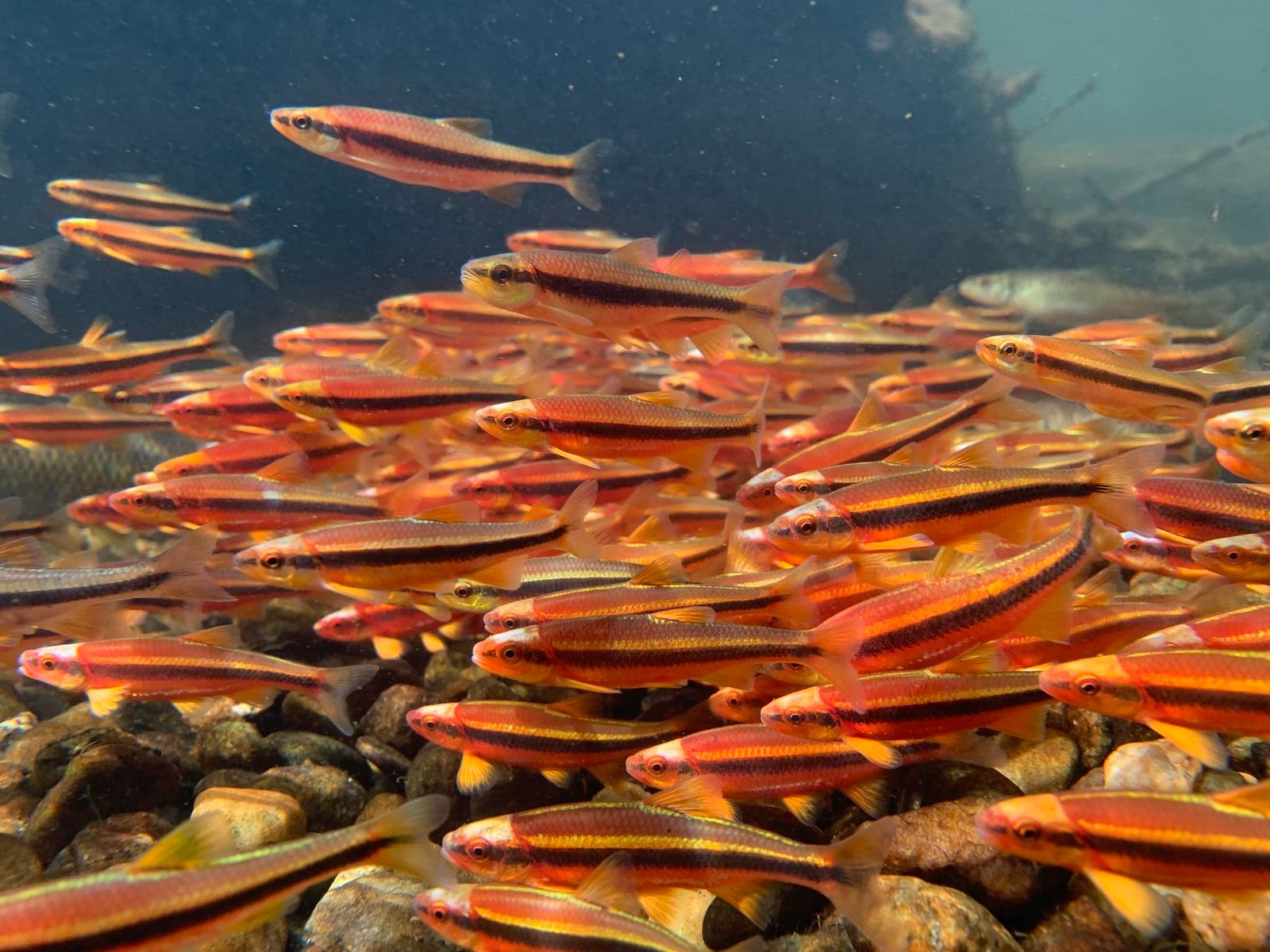
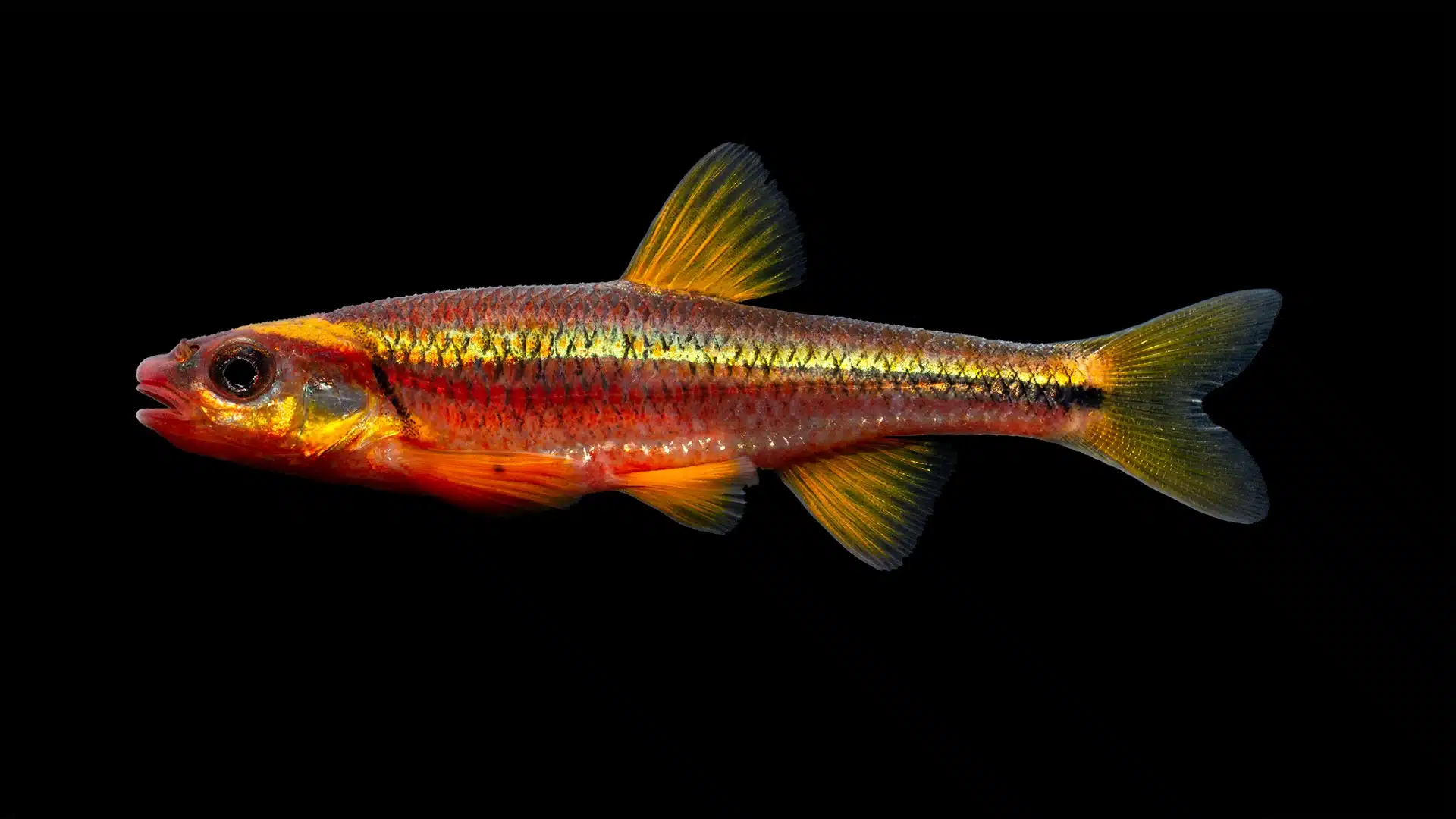


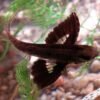







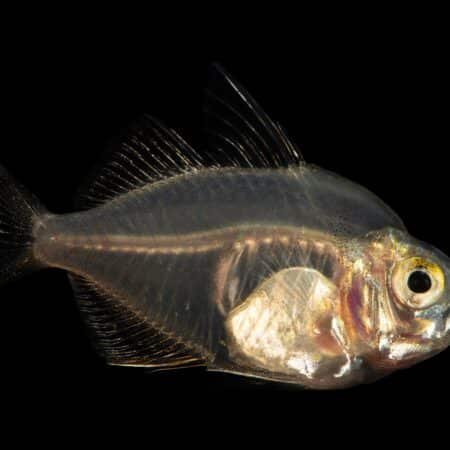
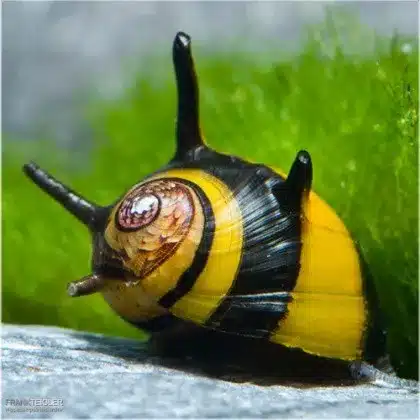

Emily Richards (verified owner) –
I recently purchased the 5 Yellowfin Shiners (Notropis lutipinnis), and I couldn’t be happier! After introducing them into my 55-gallon community tank, they quickly became the stars of the show. These gorgeous little fish, around 3-4 cm, are so vibrant, and their shimmering yellow fins add a delightful pop of color to my aquarium. It’s been about two weeks since they arrived, and they’ve not only adapted beautifully but have also become quite social, often schooling together in the open water, which is a joy to watch.
I appreciate that they are peaceful and get along with my other tropical fish. Their active nature means they need a bit of space, so I recommend having a larger tank with plenty of plants and hiding spots. They are also quite easy to feed; I’ve been using high-quality flakes and occasionally live food, and they seem to thrive!
If you’re a caring fish parent looking to add lively and beautiful species to your aquarium, these Yellowfin Shiners are a fantastic choice. Just be sure to monitor water conditions, as they do best in well-maintained environments. I can confidently say that I would purchase these again without hesitation. Highly recommend for both beginners and experienced aquarists!
Emily Carter (verified owner) –
I recently added the 5 Yellowfin Shiners to my 55-gallon community tank, and I couldn’t be happier! These little beauties are about 3-4 cm each and bring an explosion of color and energy to my aquarium. Their schooling behavior is simply mesmerizing to watch. After just one week, they’ve settled in beautifully and are already interacting with my other freshwater fish.
I’ve kept fish for several years now, and I’ve tried various species, but the Yellowfin Shiners have become my instant favorite. Unlike some other schooling fish I’ve had, they’re incredibly hardy and seem to thrive in a variety of water conditions, which is great for beginners.
One minor concern was that they were a bit shy initially, but with a little patience, they became more outgoing. For anyone looking to enhance their aquarium with vibrant, tropical fish that are easy to care for, I highly recommend these lovely little guys. They truly bring happiness to my tank! Plus, shipping was quick, and they arrived healthy and well-packaged. Would definitely buy from here again!